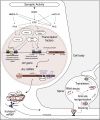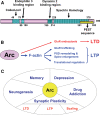The Arc of synaptic memory
- PMID: 19690847
- PMCID: PMC2803749
- DOI: 10.1007/s00221-009-1959-2
The Arc of synaptic memory
Erratum in
- Exp Brain Res. 2011 Mar;209(2):317
Abstract
The immediate early gene Arc is emerging as a versatile, finely tuned system capable of coupling changes in neuronal activity patterns to synaptic plasticity, thereby optimizing information storage in the nervous system. Here, we attempt to overview the Arc system spanning from transcriptional regulation of the Arc gene, to dendritic transport, metabolism, and translation of Arc mRNA, to post-translational modification, localization, and degradation of Arc protein. Within this framework we discuss the function of Arc in regulation of actin cytoskeletal dynamics underlying consolidation of long-term potentiation (LTP) and regulation of AMPA-type glutamate receptor endocytosis underlying long-term depression (LTD) and homeostatic plasticity. Behaviorally, Arc has a key role in consolidation of explicit and implicit forms of memory, with recent work implicating Arc in adaptation to stress as well as maladaptive plasticity connected to drug addiction. Arc holds considerable promise as a "master regulator" of protein synthesis-dependent forms of synaptic plasticity, but the mechanisms that modulate and switch Arc function are only beginning to be elucidated.
Figures



References
-
- Banerjee PS, Aston J, Khundakar AA, Zetterstrom TS. Differential regulation of psychostimulant-induced gene expression of brain derived neurotrophic factor and the immediate-early gene Arc in the juvenile and adult brain. Eur J Neurosci. 2009;29(3):465–476. - PubMed
Publication types
MeSH terms
Substances
LinkOut - more resources
Full Text Sources
Other Literature Sources
Medical

